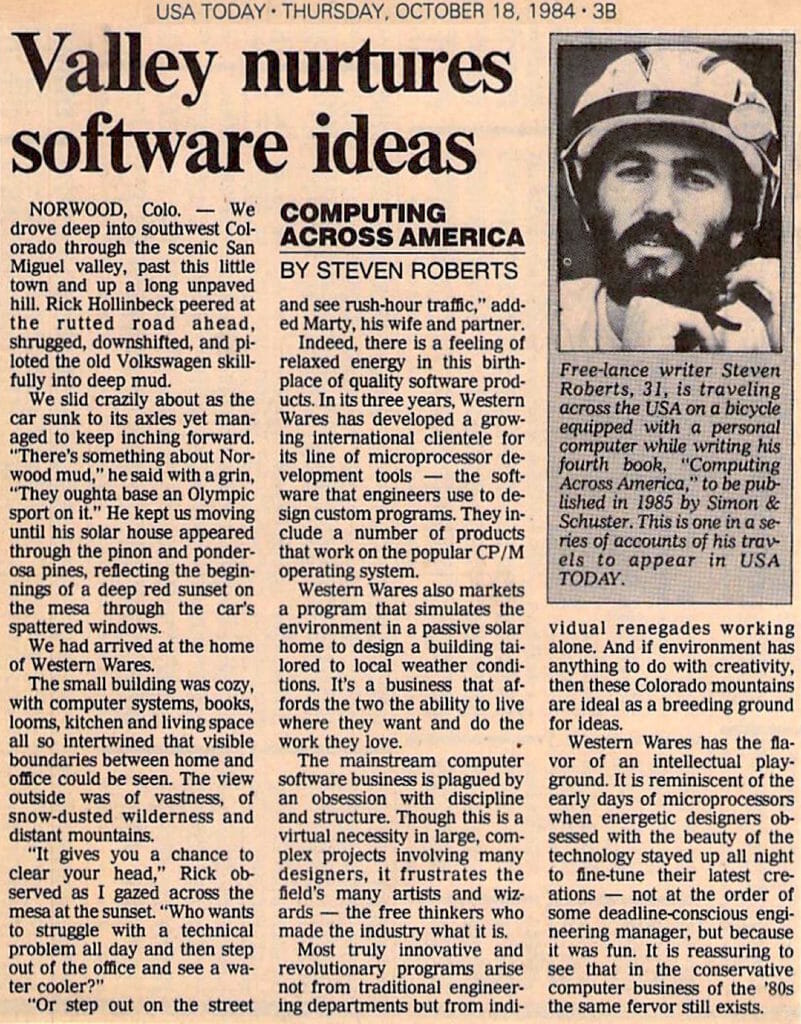
Valley Nurtures Software Ideas
Part of my column in USA Today while pedaling across the US…
by Steven K. Roberts
USA Today
October 18, 1984
NORWOOD, Colo. — We drove deep into southwest Colorado through the scenic San Miguel valley, past this little town and up a long unpaved hill. Rick Hollinbeck peered at the rutted road ahead, shrugged, downshifted, and piloted the old Volkswagen skill fully into deep mud.
We slid crazily about as the car sunk to its axles yet managed to keep inching forward. “There’s something about Norwood mud,” he said with a grin, “They oughta base an Olympic sport on it” He kept us moving until his solar house appeared through the piñon and ponderosa pines, reflecting the beginnings of a deep red sunset on the mesa through the car’s spattered windows.
We had arrived at the home of Western Wares.
The small building was cozy, with computer systems, books, looms, kitchen and living space all so intertwined that no visible boundaries between home and office could be seen. The view outside was of vastness, of snow-dusted wilderness and distant mountains.
“It gives you a chance to clear your head,” Rick observed as I gazed across the mesa at the sunset. “Who wants to struggle with a technical problem all day and then step out of the office and see a water cooler?”
“Or step out on the street and see rush-hour traffic,” added Marty, his wife and partner.
Indeed, there is a feeling of relaxed energy in this birthplace of quality software products. In its three years, Western Wares has developed a growing international clientele for its line of microprocessor development tools — the software that engineers use to design custom programs. They include a number of products that work on the popular CP/M operating system.
Western Wares also markets a program that simulates the environment in a passive solar home to design a building tailored to local weather conditions. It’s a business that affords the two the ability to live where they want and do the work they love.
The mainstream computer software business is plagued by an obsession with discipline and structure. Though this is a virtual necessity in large, complex projects involving many designers, it frustrates the field’s many artists and wizards — the free thinkers who made the industry what it is.
Most truly innovative and revolutionary programs arise not from traditional engineering departments but from individual renegades working alone. And if environment has anything to do with creativity, then these Colorado mountains are ideal as a breeding ground for ideas.
Western Wares has the flavor of an intellectual playground. It is reminiscent of the early days of microprocessors when energetic designers obsessed with the beauty of the technology stayed up all night to fine-tune their latest creations — not at the order of some deadline-conscious engineering manager, but because it was fun. It is reassuring to see that in the conservative computer business of the ’80s the same fervor still exists.
NOTE: My 2004 essay on Gonzo Engineering says more on this theme…

